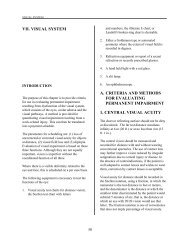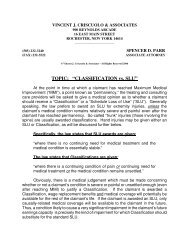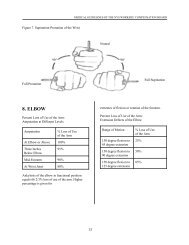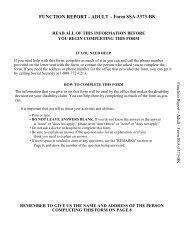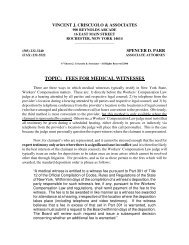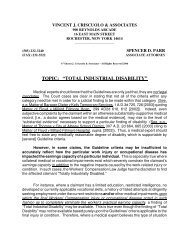Hernia
Hernia
Hernia
You also want an ePaper? Increase the reach of your titles
YUMPU automatically turns print PDFs into web optimized ePapers that Google loves.
LESS COMMON WORK RELATED CONDITIONS AND DISORDERS<br />
V. LESS COMMON WORK<br />
RELATED CONDITIONS AND<br />
DISORDERS<br />
A. MEDICAL DISORDERS<br />
The above work-related medical conditions are<br />
drawn from review of medical records, consultant<br />
reports and physical examination findings. If<br />
claimant has finished treatment, is completely<br />
asymptomatic and has no physical findings, one<br />
may be given no disability. Symptomatic disabling<br />
cases may be given permanent partial or total<br />
disability depending on severity of symptoms,<br />
clinical findings and functional impairment.<br />
1. WORK RELATED<br />
DERMATITIS<br />
1. The Workers' Compensation Law Judge<br />
must establish accident or occupational Such cases always have neuro-psychiatric<br />
disease, notice and causal relation. and psychological evaluations and<br />
opinions in the file. There are also court hearing<br />
2. There must be a history of exposure to testimonies of psychiatrists and<br />
irritants and chemicals in the place of<br />
employment.<br />
psychologists on record.<br />
3. The Medical Examiner must review<br />
medical records, dermatologist reports,<br />
diagnostic testing, response to medication<br />
and treatment.<br />
4. The examining physician must perform a<br />
thorough examination of affected areas<br />
and describe active and residual lesions.<br />
2. CAUSALLY RELATED<br />
INFECTIOUS DISEASES<br />
1. Herpes simplex, autoimmune deficiency<br />
syndrome, infectious and viral hepatitis<br />
42<br />
are the most common infectious diseases<br />
seen as work related. Such cases often<br />
seen among health care providers and<br />
ancillary workers.<br />
2. There is usually a history of exposure.<br />
3. It is important to review medical records,<br />
hospitalization and diagnostic tests (i.e.,<br />
blood studies). If needed, request an<br />
infectious disease consultant opinion.<br />
4. The examining physician must consider<br />
the period of time which has elapsed since<br />
the claimant's exposure as well as the<br />
severity of the condition.<br />
3. WORK RELATED POST<br />
TRAUMATIC NEUROSIS;<br />
POST TRAUMATIC STRESS<br />
DISORDER AND OTHER<br />
CAUSALLY RELATED<br />
PSYCHIATRIC CONDITIONS<br />
SURGICAL DISORDERS<br />
A. HERNIA<br />
1. Accident or occupational disease, notice<br />
and causal relation must be established by<br />
the Workers' Compensation Law Judge.<br />
2. There should be a history of trauma,<br />
lifting or pulling.<br />
3. The examining physician must review the<br />
medical records, surgeon's reports,<br />
operative reports and physical exam. All<br />
hernias which remain symptomatic<br />
following repair or multiple repairs are<br />
considered partial disabilities for a period
MEDICAL GUIDELINES OF THE NYS WORKERS’ COMPENSATION BOARD<br />
of one to two years. <strong>Hernia</strong>s, recurrent or c. Common disfigurements of the lips<br />
not, which are symptomatic and require include loss of soft tissue, enlargement,<br />
wearing a truss, may after two years be and alteration of normal contour of the<br />
classified permanent partial disability. lips.<br />
Cases that are successfully repaired and<br />
asymptomatic are given no disability. d. Common disfigurements of the ear<br />
B. CAUSALLY RELATED<br />
SURGICAL EXCISION OF<br />
VITAL ORGANS<br />
Surgical excision (partial or total) of vital organs,<br />
usually following a history of trauma, such as<br />
excision of a spleen, removal of one kidney,<br />
partial excision of the liver, partial excision of<br />
lung tissue and /or lobectomy, and orchiectomy<br />
are classified permanent partial disability.<br />
C. FACIAL SCARS AND<br />
DISFIGUREMENT<br />
1. Permanent scars and disfigurement of the<br />
face and neck are usually evaluated one<br />
year post-injury and/or one year after the<br />
last surgical procedure was performed.<br />
2. Scars and disfigurement involving the<br />
neck are limited to the region above the<br />
clavicle.<br />
3. The scar and disfigurement should be<br />
described accurately, using such<br />
parameters as length, width, color,<br />
contour, and exact location.<br />
4. Specific disfigurements of the eye, ear,<br />
nose and mouth are also to be noted.<br />
a. Common disfigurements of the eye<br />
include corneal scarring; defects of the<br />
iris and in some instances total loss of the<br />
eye with use of a prosthesis.<br />
b Common disfigurements of the nose<br />
include nasal septal deviation,<br />
enlargement and tissue loss.<br />
43<br />
include loss of tissue and alteration of<br />
normal contour of the ear.<br />
e. If teeth are damaged, the dentist’s report<br />
should be consulted.




